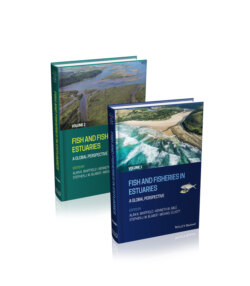Читать книгу Fish and Fisheries in Estuaries - Группа авторов - Страница 51
3.3.1.2 Swimming as a transport mechanism
ОглавлениеVertical swimming behaviour is well known in early‐stage fish larvae and is executed by many taxa in offshore regions prior to entering estuarine nurseries. Diel vertical migrations, for example, are reported for offshore postflexion larvae of the clupeid Brevoortia tyrannus (Forward et al. 1999) or for pelagic larvae of the soleid Solea solea (Champalbert & Koutsikopoulos 1995). The diel vertical migrations appear to be endogenous behaviours that facilitate shoreward transport via depth regulation.
Swimming from offshore to the coast by postflexion larvae with developed fins provides a potential mechanism for transport to the coast. Postflexion fish larvae can swim at relative speeds several times their body length per second, at least for many late‐stage larvae of tropical and temperate fishes. Remarkably, they can swim at those speeds for hours or days (Bellwood & Fisher 2001, Clark et al. 2005, Leis 2006, Pattrick & Strydom 2009, Leis et al. 2013). As such, postflexion fish larvae of some species may swim to (or towards) estuaries, especially if they have cues to guide them. For example, swimming may be the mechanism used by the pomatomid Pomatomus saltatrix in the western North Atlantic (Hare & Cowen 1993) to transit from the Gulf Stream edge to coastal and estuarine nurseries on the US Atlantic coast.
Swimming is probably also the mechanism used by the glass‐eel stage of anguillid eels, Anguilla rostrata and A. anguilla, entering North American and European estuaries (Wuenschel & Able 2008) and A. japonica ingressing to Japanese estuaries (Tsukamoto 1990, Fukuda et al. 2016). Larvae of taxa from high latitudes (with lower temperatures) may have less swimming capability, but they too swim surprisingly well. Clark et al. (2005) conducted experiments on larvae that included the estuarine sciaenid Argyrosomus japonicus whose critical swimming speed (expressed as body lengths per second, BL s−1) increased from about 5 BL s−1 at 5 mm standard length to >10 BL s−1 at 10 mm SL. Furthermore, endurance, expressed as swimming distance, increased rapidly from a negligible distance for the smallest <5 mm larvae to ~15 km for 13 mm SL postflexion larvae (Figure 3.10).
Swimming ability of the warm‐temperate estuarine sciaenid Sciaenops ocellatus, tested in the laboratory, increased rapidly in early‐stage larvae (<7 mm TL) to about 10 cm s−1 (~14 BL s−1) at 7 mm TL and then more slowly later in development (Faria et al. 2009). In laboratory experiments, larvae of the temperate Diplodus sargus increased sustained swimming speed from about 5 BL s−1 at 5–10 mm TL to about 14 BL s−1 at 15 mm TL and 50 days posthatch (Baptista et al. 2019). The late‐stage larvae of two warm‐temperate sparid species, Sarpa salpa and Diplodus capensis (approximately 10–20 mm SL), had similar critical swimming speeds of 19 and 18 cm s−1, respectively, speeds that exceed mean nearshore current velocities near their coastal nurseries (Pattrick & Strydom 2009). In these examples, swimming durations (endurances) of larvae >10 mm in length can be expressed as days. Potential distances swum can be in the 10–100 km range, indicating that directed swimming from offshore by late‐stage larvae can partly account for larval ingress into estuaries. A recent analysis of several Mediterranean Sea species, including estuarine/coastal taxa (e.g. Mugilidae, Sparidae), confirms the substantial swimming ability of postflexion larvae and potential to direct their inshore dispersal (Rossi et al. 2019b).
Figure 3.10 Ontogeny of swimming performance, critical swimming speeds (cm sec−1) and swimming endurance (km swum) for larvae of Argyrosomus japonicus, an estuarine sciaenid fish
(from Clark et al. 2005, their figure 1).
Bars represent morphological developmental landmarks and settlement.
Models of swimming performance also indicate that swimming can significantly influence trajectories and transport to estuaries. Irisson et al. (2009), based on numerical modelling, believed that swimming speeds of 1–5 cm s−1 would be sufficient to strongly influence dispersal outcomes (Codling et al. 2004). Near Georges Bank, in the Western North Atlantic, Werner et al. (1993) noted that swimming by fish larvae of only 0.3–1.0 cm s−1 could substantially enhance shoalward displacement. In a numerical model of the Florida coast, simulated larvae, swimming at only 1 cm s−1, achieved settlement rates on nearshore reefs 36–300% greater than passive larvae (Porch 1998). In a model of an Australian coral reef, a swimming speed of 10 cm s−1 by simulated, settlement‐stage larvae resulted in modelled recruitment levels higher than was possible if larvae were drifting passively (Wolanski and Kingsford 2014).
In a further example showing the likely importance of directional swimming, the larval recruitment process was modelled for the Ria Formosa, a coastal lagoon in Portugal with extensive seagrass beds (Teodosio et al. 2016, Baptista et al. 2020). Tidal currents in the lagoon created an apparent odour plume extending several kilometres offshore and alongshore in coastal waters. Several fish species, including the clupeid Sardina pilchardus, the engraulid Engraulis encrasicolus, and the sparid Diplodus sargus spawn near the coast and close to Ria Formosa. They entered the lagoon as postflexion larvae by swimming towards the lagoon and may use the estuary plume to orient their swimming through olfactory and taste senses. The modelled results of sensory response to odour and directional swimming suggested that, neglecting mortality, typically 30–50% of the directionally swimming postflexion larvae of S. pilchardus and E. encrasicolus could recruit to Ria Formosa, a level an order‐of‐magnitude higher than the fraction predicted without directional swimming.
